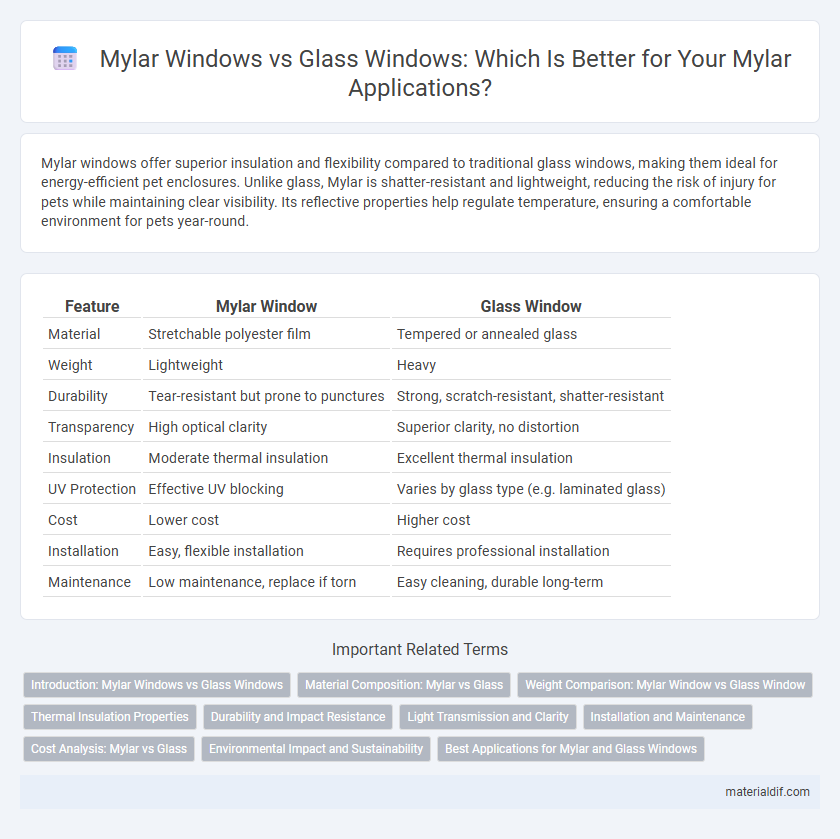Mylar windows offer superior insulation and flexibility compared to traditional glass windows, making them ideal for energy-efficient pet enclosures. Unlike glass, Mylar is shatter-resistant and lightweight, reducing the risk of injury for pets while maintaining clear visibility. Its reflective properties help regulate temperature, ensuring a comfortable environment for pets year-round.
Table of Comparison
| Feature | Mylar Window | Glass Window |
|---|---|---|
| Material | Stretchable polyester film | Tempered or annealed glass |
| Weight | Lightweight | Heavy |
| Durability | Tear-resistant but prone to punctures | Strong, scratch-resistant, shatter-resistant |
| Transparency | High optical clarity | Superior clarity, no distortion |
| Insulation | Moderate thermal insulation | Excellent thermal insulation |
| UV Protection | Effective UV blocking | Varies by glass type (e.g. laminated glass) |
| Cost | Lower cost | Higher cost |
| Installation | Easy, flexible installation | Requires professional installation |
| Maintenance | Low maintenance, replace if torn | Easy cleaning, durable long-term |
Introduction: Mylar Windows vs Glass Windows
Mylar windows offer lightweight, shatter-resistant alternatives to traditional glass windows, making them ideal for applications requiring durability and flexibility. Unlike glass, Mylar provides superior UV resistance and reduced thermal transfer, enhancing energy efficiency in building environments. Its transparency and impact resistance make Mylar an attractive choice for residential and commercial window solutions comparing favorably to conventional glass.
Material Composition: Mylar vs Glass
Mylar windows consist of stretched polyester film coated with a thin layer of metal, offering lightweight durability and excellent insulation properties, whereas traditional glass windows are made from silica-based materials that provide rigidity and transparency but are heavier and more fragile. Mylar's polymer structure allows for flexibility and resistance to impact, making it suitable for applications requiring lightweight barriers, while glass's crystalline composition delivers high optical clarity and strength under compression. The distinct material compositions affect thermal performance, with Mylar reducing heat transfer through reflective coatings, contrasting glass's conductive nature that requires additional treatments for energy efficiency.
Weight Comparison: Mylar Window vs Glass Window
Mylar windows weigh significantly less than traditional glass windows, with Mylar films typically weighing only a fraction of the glass counterparts, often less than 0.1 pounds per square foot compared to glass, which can weigh upwards of 2.5 pounds per square foot. This substantial weight difference makes Mylar windows ideal for applications requiring lightweight materials, such as portable shelters or greenhouses. Reduced weight not only facilitates easier installation and transport but also lowers structural support demands.
Thermal Insulation Properties
Mylar windows provide superior thermal insulation compared to traditional glass windows due to their low emissivity and high reflectivity, effectively reducing heat transfer. The multi-layered polyester film structure of Mylar minimizes heat loss in winter and heat gain in summer, enhancing energy efficiency in buildings. Glass windows typically have higher thermal conductivity, making them less effective at insulating against temperature fluctuations than Mylar films.
Durability and Impact Resistance
Mylar windows offer superior impact resistance compared to traditional glass windows, making them ideal for areas prone to storms or breakage. Unlike glass, Mylar is highly durable, flexible, and shatterproof, significantly reducing the risk of injury and damage upon impact. This durability enhances safety and can extend the lifespan of window installations in extreme weather conditions.
Light Transmission and Clarity
Mylar windows offer high light transmission rates, often exceeding 90%, allowing ample natural light while reducing glare compared to traditional glass windows. Unlike glass, Mylar maintains clarity without distortion and resists shattering, making it a safer and more durable alternative. Its lightweight and flexible nature enhances installation options while preserving visual transparency in various environments.
Installation and Maintenance
Mylar windows offer quicker and simpler installation compared to traditional glass windows, requiring fewer tools and less labor time due to their lightweight and flexible nature. Maintenance for Mylar windows is minimal, with easy cleaning using mild soap and water, and no risk of cracks or shattering, unlike glass which demands careful handling and periodic sealing to prevent leaks. The durability of Mylar, combined with its resistance to environmental damage, reduces overall upkeep costs and extends the lifespan of window installations.
Cost Analysis: Mylar vs Glass
Mylar windows typically offer a cost-effective alternative to glass windows, with material and installation expenses often 50-70% lower. Glass windows require higher upfront investment due to the cost of manufacturing, transportation, and specialized installation, which can increase overall project budgets. Over time, Mylar's affordability makes it a preferred option for budget-conscious projects needing lightweight and flexible window solutions.
Environmental Impact and Sustainability
Mylar windows significantly reduce energy consumption by enhancing insulation and minimizing heat transfer compared to traditional glass windows, contributing to lower carbon emissions. The production of Mylar film requires fewer raw materials and generates less waste, making it a more sustainable option in manufacturing. Its lightweight nature reduces transportation emissions and facilitates recycling, further supporting environmental sustainability efforts.
Best Applications for Mylar and Glass Windows
Mylar windows excel in applications requiring lightweight, shatter-resistant, and energy-efficient solutions, making them ideal for greenhouses, emergency shelters, and lightweight architectural installations. Glass windows provide superior clarity, durability, and sound insulation, suited for residential, commercial buildings, and areas demanding high visibility and weather resistance. Selecting between Mylar and glass depends on priorities like impact resistance, thermal insulation, and design flexibility in specific environmental conditions.
Mylar Window vs Glass Window Infographic

 materialdif.com
materialdif.com